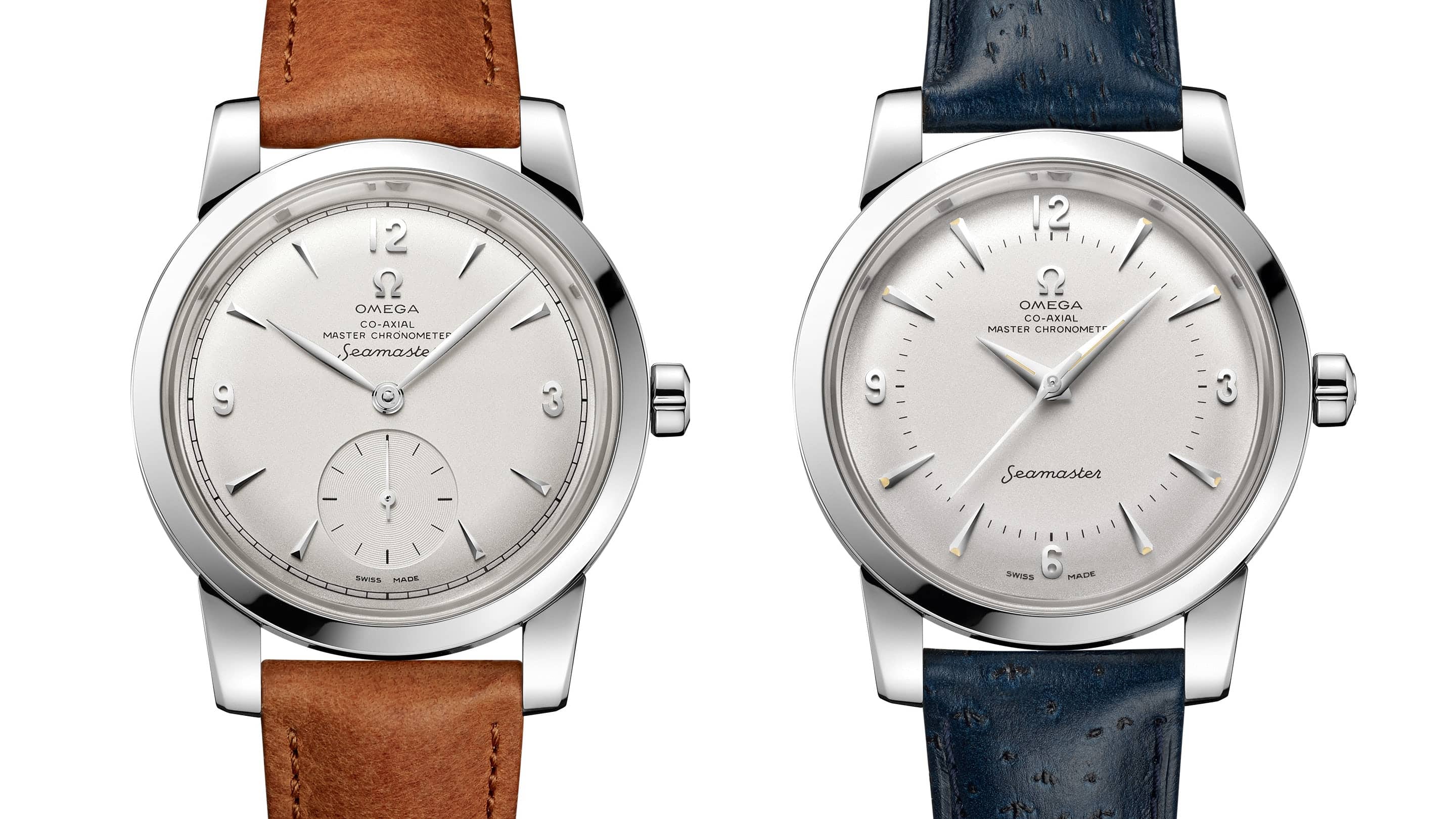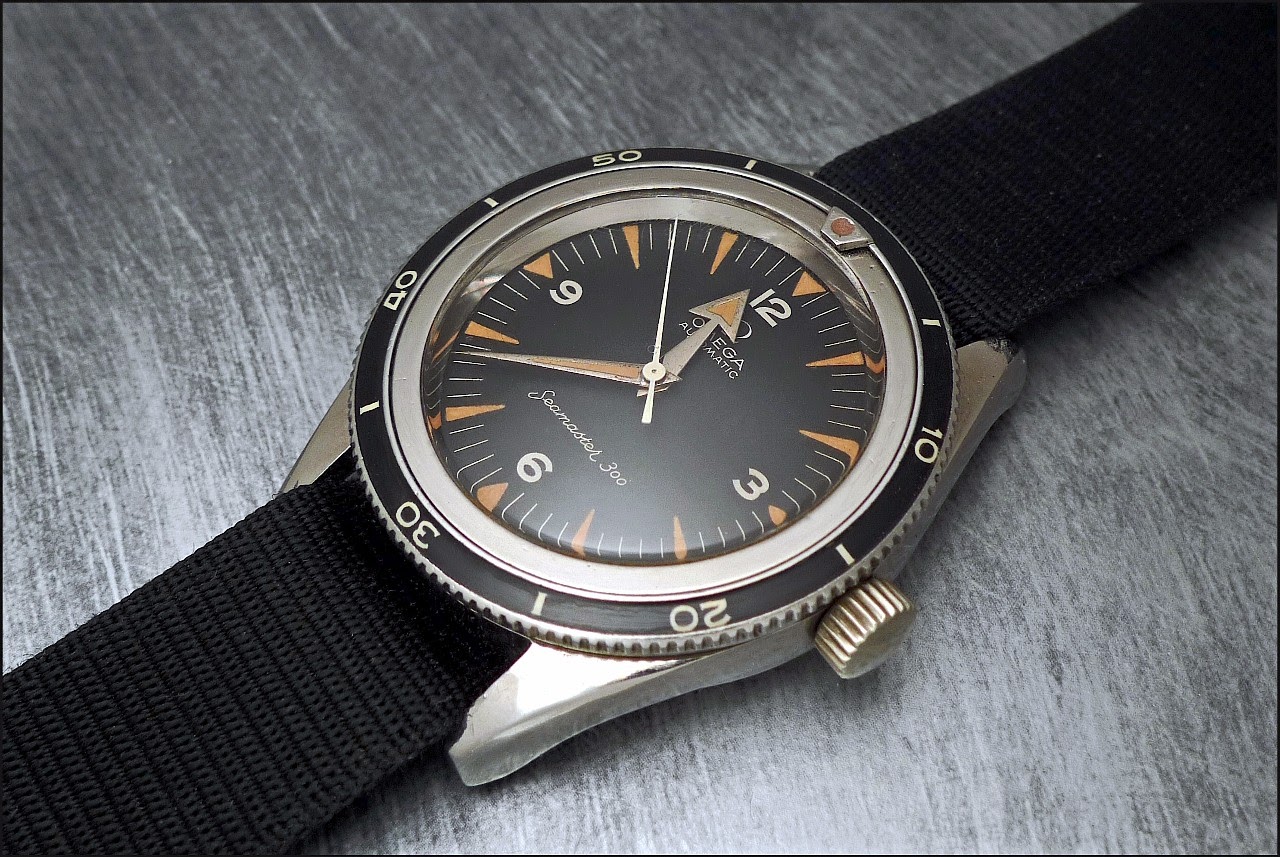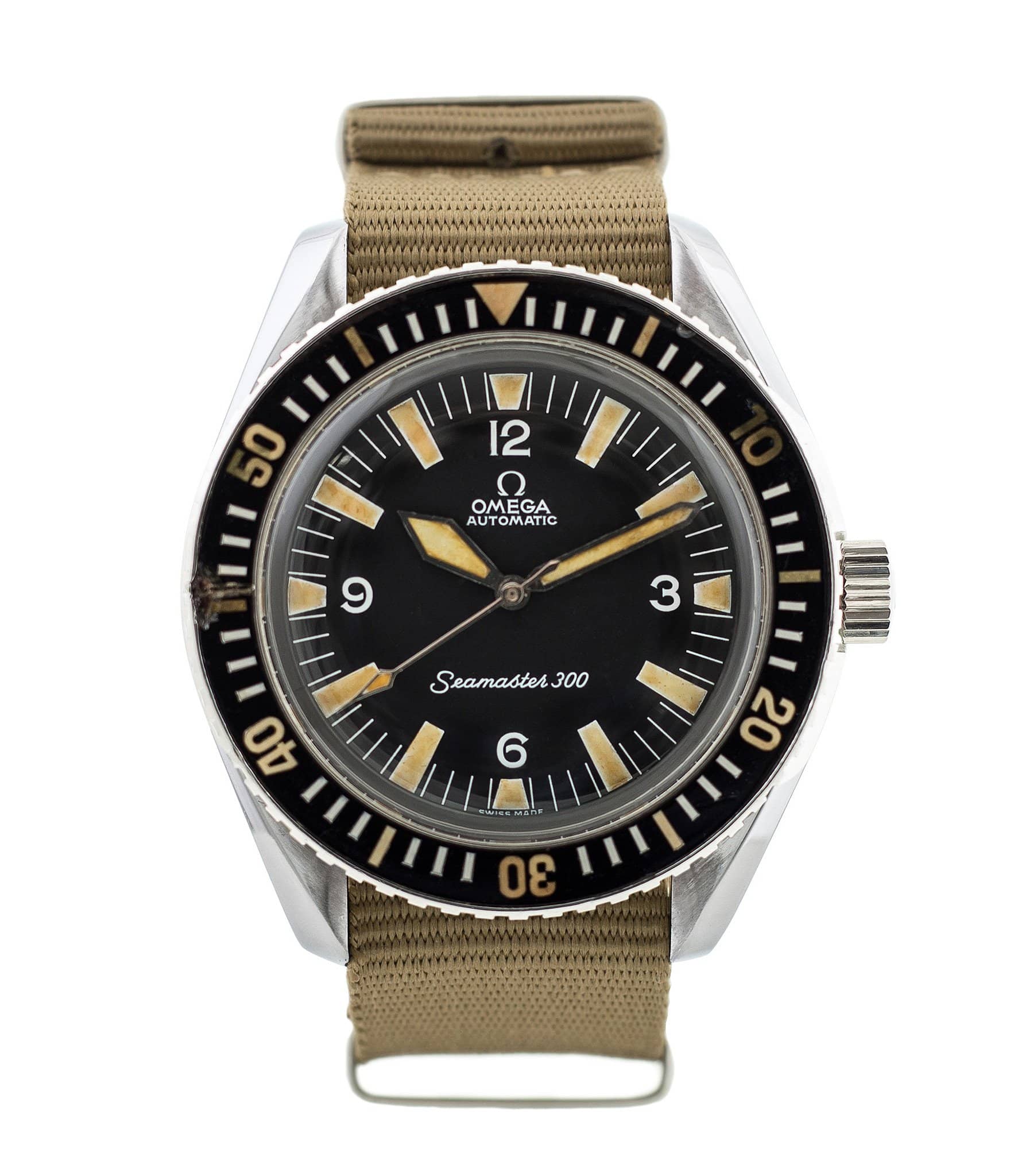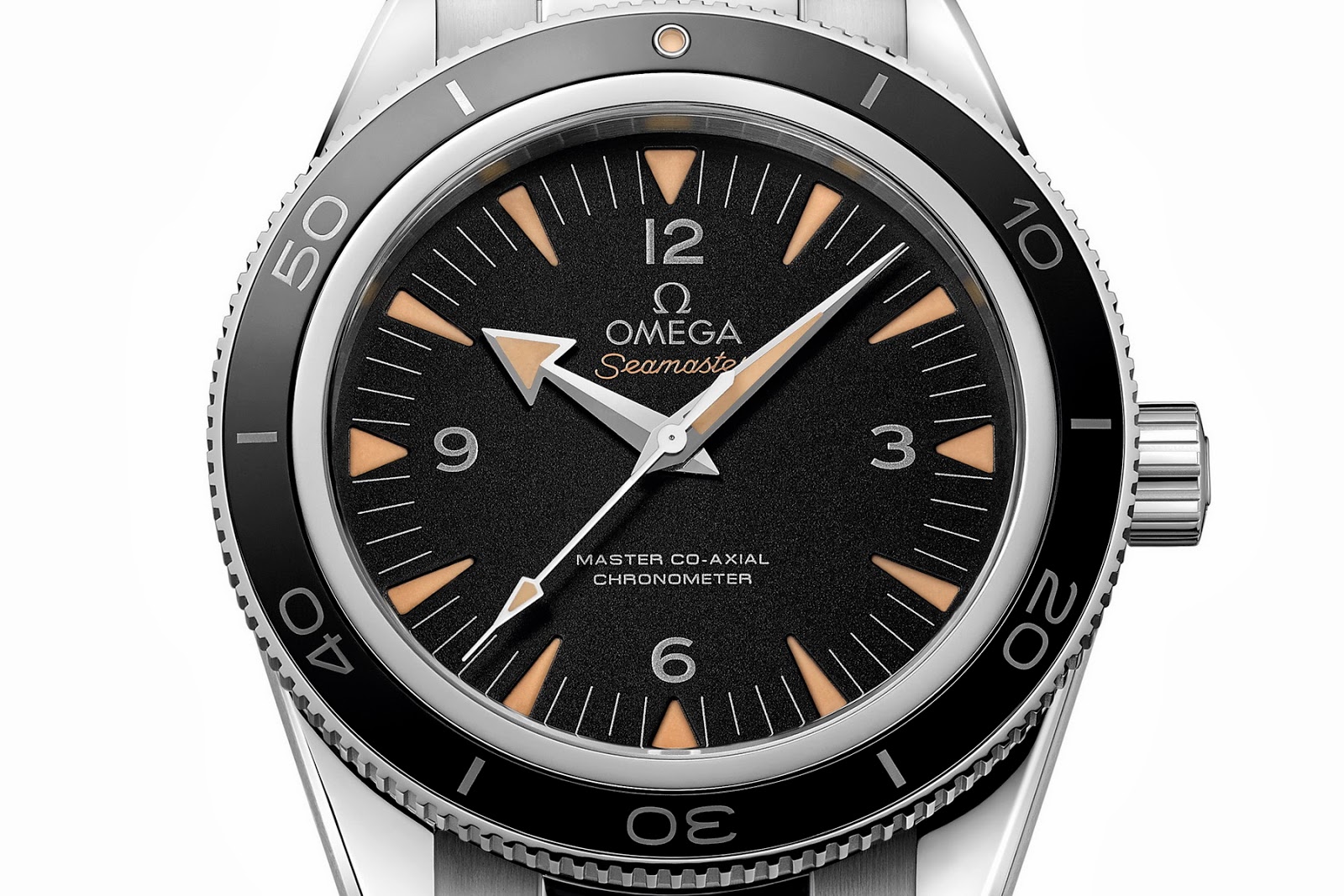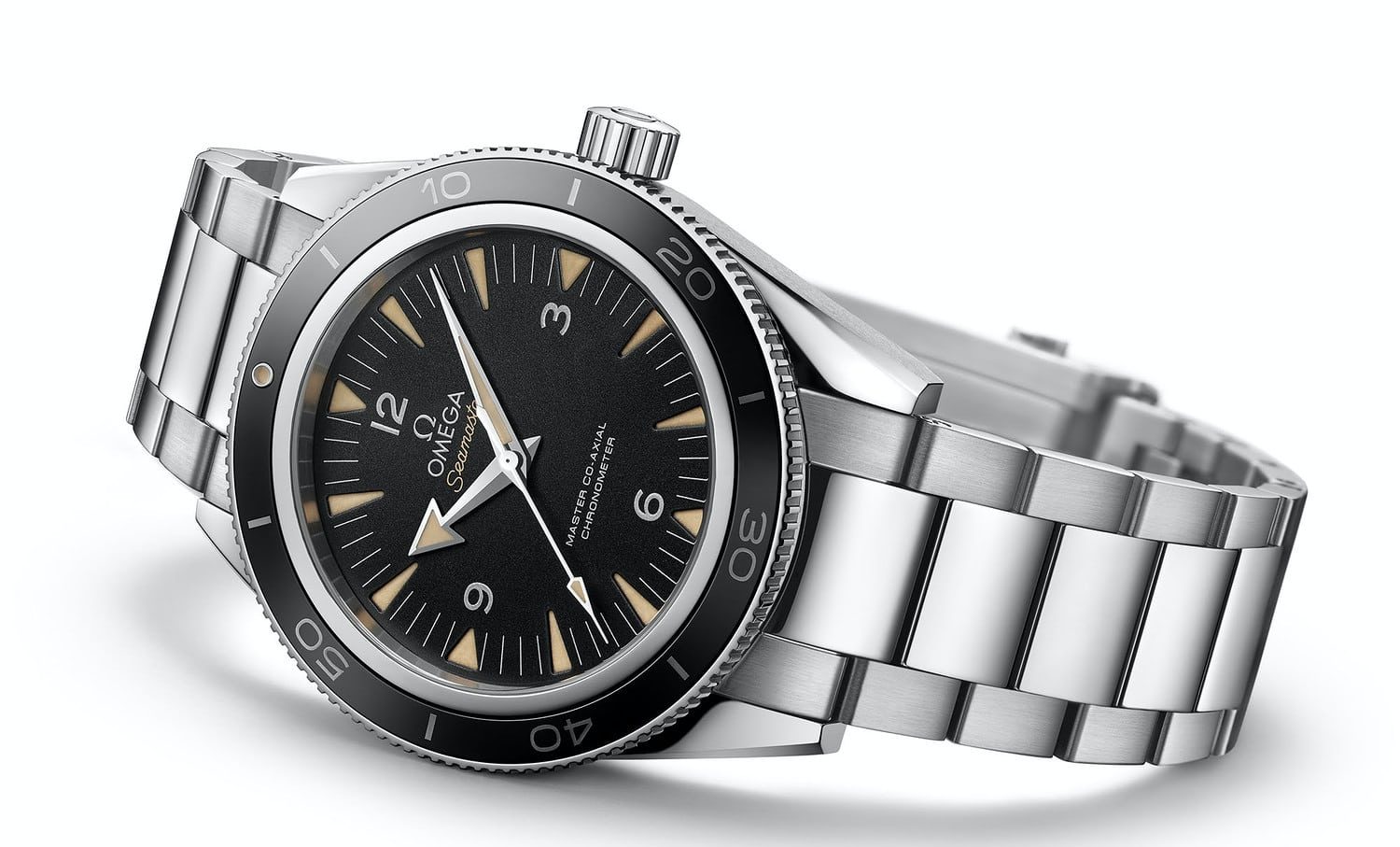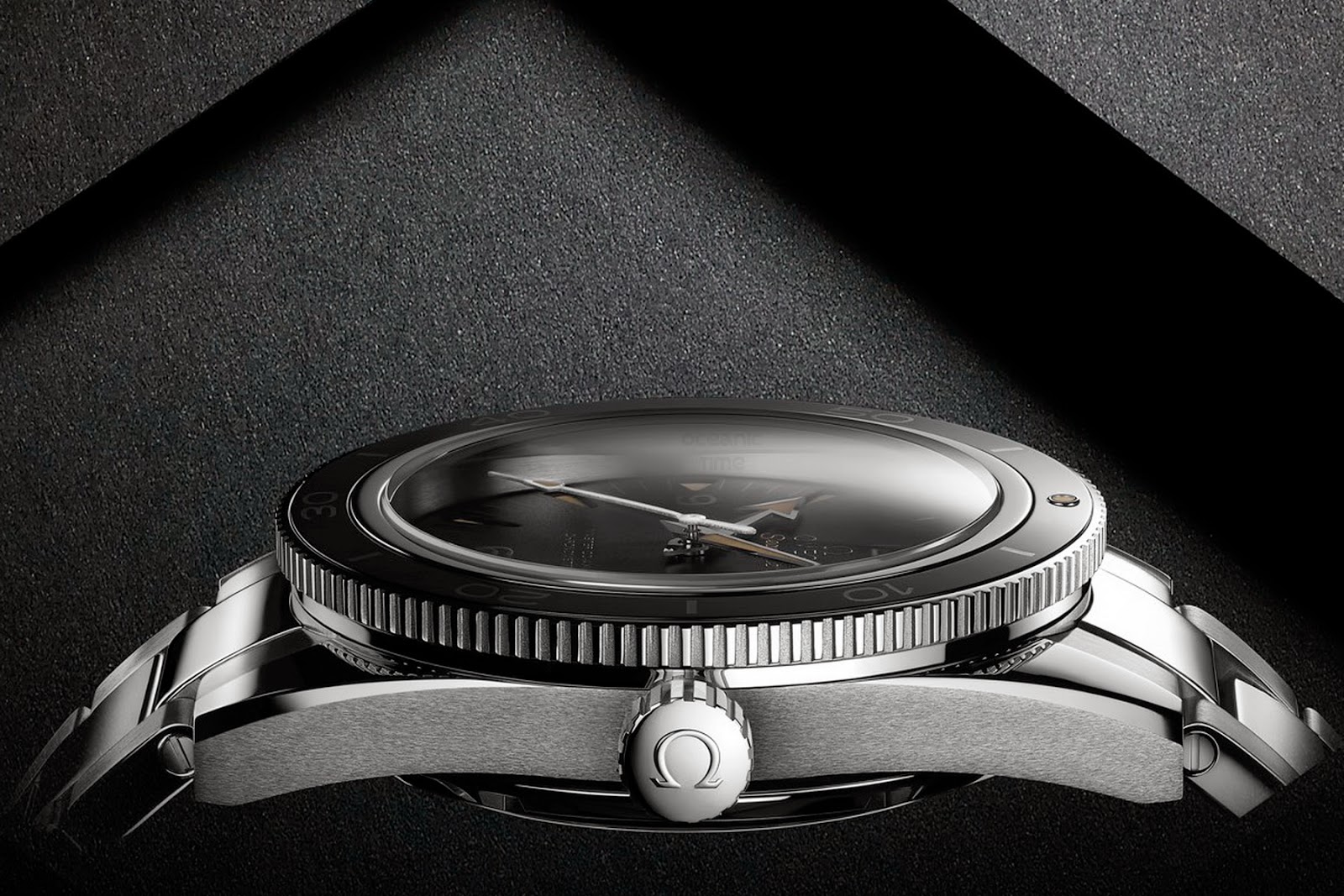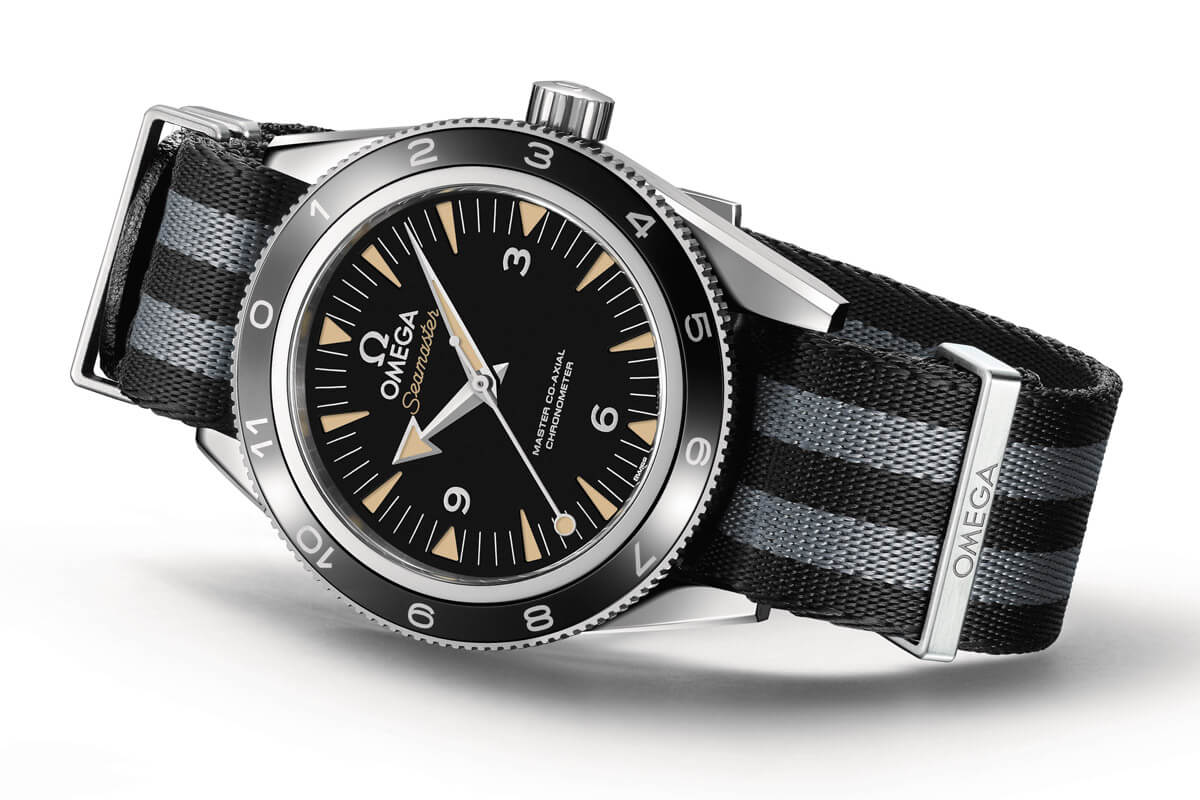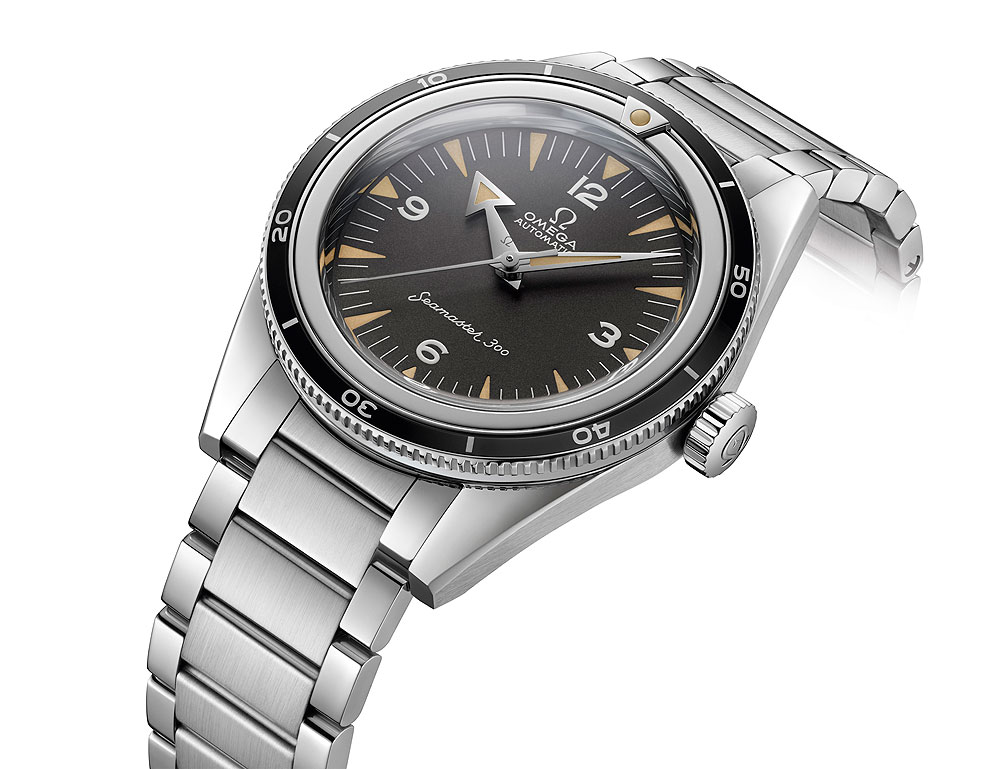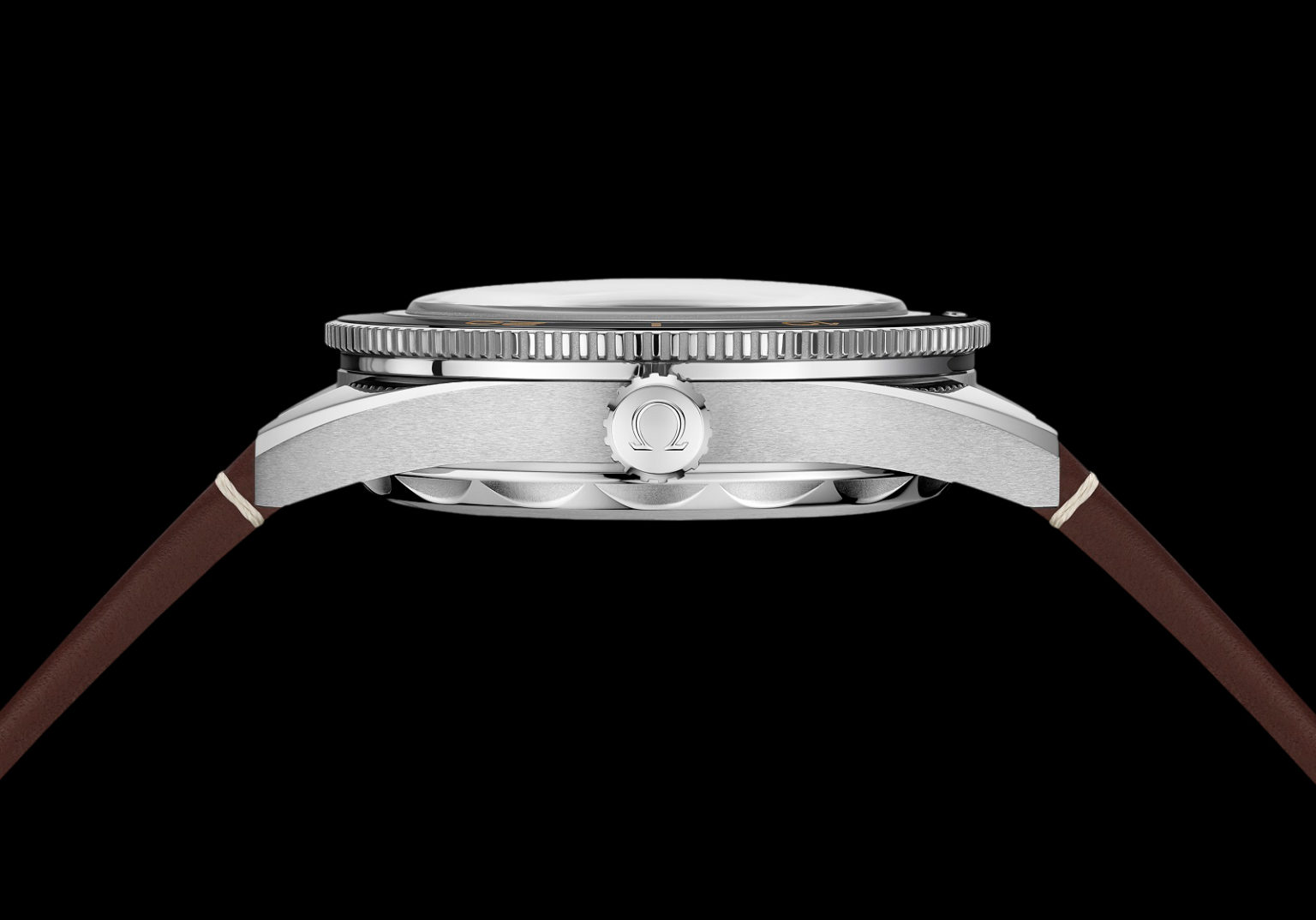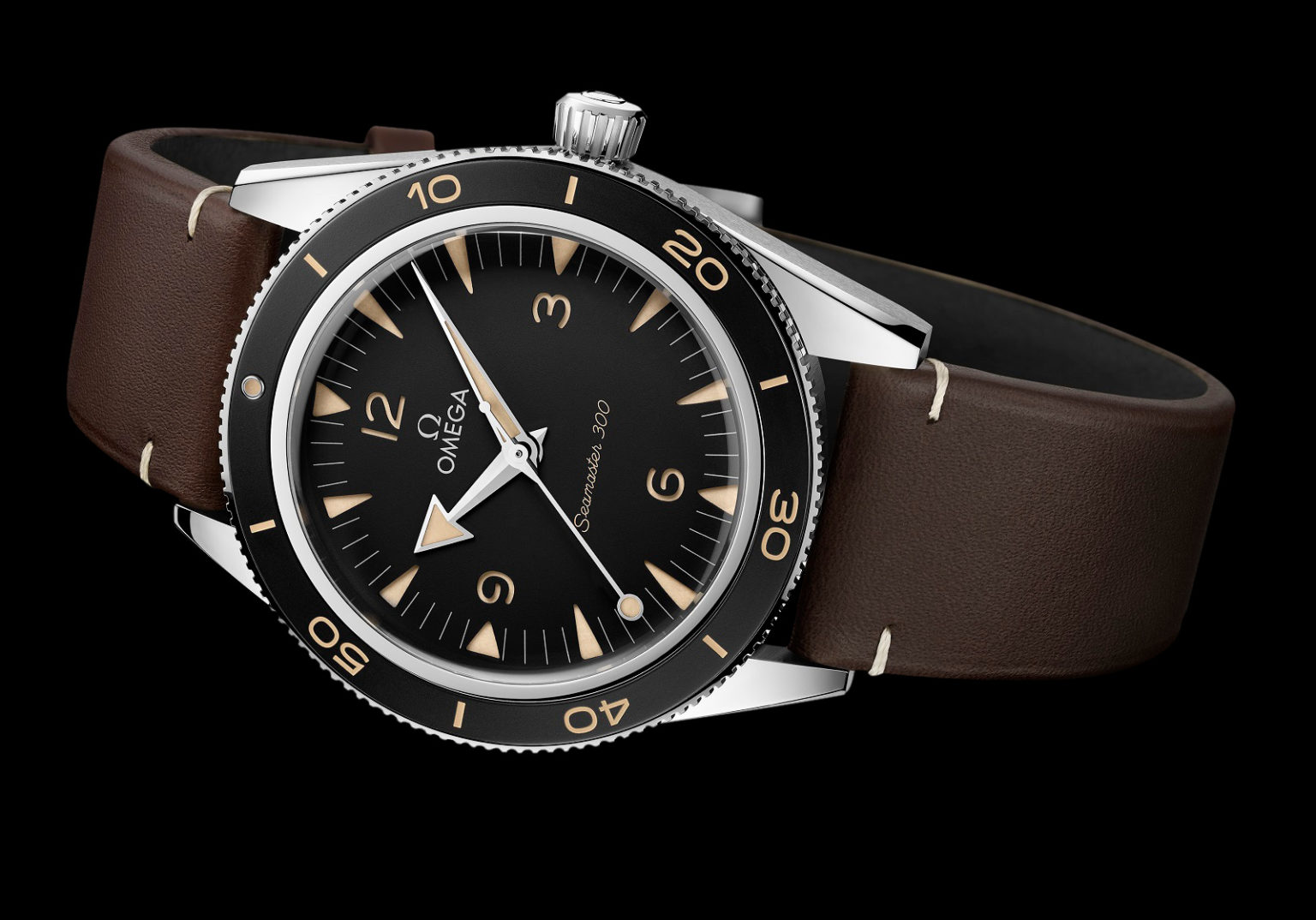This is the latest version of the Omega Seamaster 300 Master Chronometer. The heritage-style Omega Seamaster inspired – at least in part – by the OG Ref CK2913 from 1957. It’s a good-looking steel dive watch with a sandwich dial and a generous helping of beige lume. Also known in the business as fauxtina, or fake patina. If you’re into that sort of thing it adds some nice character to the dial. Although people on the internet remain divided on the issue. But that’s a topic for another article. What we’re here to discuss today is whether the Omega Seamaster 300 is a good buy.
A (Very) Brief History Of The Seamaster 300
It might surprise you to learn that the Seamaster did not start out life as a dive watch. Instead it came to market as a robust dress watch for the active gentleman. The early models – introduced in 1948 for Omega’s 100th anniversary – were only water resistant to 60m. Still quite good by the standards of the time but by no means suitable for diving.
- Omega recently introduced these two very stylish Seamaster 1948 Limited Editions to commemorate the original models.
To be fair though this was five years before Blancpain debuted the Fifty Fathoms in 1953. A watch now considered the blueprint for the modern dive watch. Followed almost immediately – some say at the same time – by the Rolex Submariner. Still it took Omega another four years to debut the Seamaster 300 in 1957.
It’s possible the company was slow to realise the potential of the dive watch market. Or they needed that time to develop a robust mechanical dive watch. Whatever the reason, the Seamaster 300 launched in 1957 as part of the ‘Master’ Trilogy. This also included the Speedmaster and Railmaster. And it’s no exaggeration to say an icon was born (three in fact).
The Seamaster 300 Ref CK2913
The Seamaster 300 Ref CK2913 was a dramatic overhaul of the previous dress versions. The original 34mm case increased to 39mm. The larger diameter was necessary for improved underwater legibility. The white dial changed out for black. A broad arrow introduced for the hour hand. Luminescent material (radium) defined the enlarged indexes. It also filled the time hands and provide a dot at the hour mark on the bidirectional rotatable bezel.
- A prime example of an early Omega Seamaster 300 CK2913-3. Image Credit: amancio, WatchProSite
To reinforce its diving heritage, Omega came up with the hippocampus (seahorse) insignia. Its inspiration comes from an image of Neptune riding a hippocampus-drawn chariot. The embossed symbol on the case back has since become a globally-recognised trademark.
The Seamaster 300 had a water resistance rating of 200m (equal to the Rolex Submariner). Legend has it the rating came about due to the limitations of Omega’s testing equipment. The best that was available at the time. Omega believed its dive watch was capable of deeper depths, hence the use of ‘300’ in the name.
The Second-Generation Omega Seamaster 300
The second-generation Seamaster 300 came in 1964. It featured a 42mm case and twisted lugs with polished and brushed sections. It borrowed the asymmetrical design with crown protection of the Speedmaster Professional. A clever solution developed the previous year for astronaut use.
The bezel increased in width and received luminescent markings at every five-minute interval. This made it more legible underwater, especially in the dark. And delivered a diver’s watch comparable in style to the Fifty Fathoms and Submariner.
- An OMEGA Seamaster 300 Ref 165.024 from the 1960’s. Image credit – A Collected Man.
In 1967, the Royal Navy commissioned the Seamaster 300 as their official diver’s watch. The military-issue version required several modifications. These included welded lugs to reduce the chance of losing the watch (worn with a one-piece strap). Along with a symbol on the dial indicating the use of tritium – a radioactive material. This was because the watch would be in the vicinity of sensitive equipment. Hence the appearance of an encircled ‘T’ above the Seamaster 300 label.
The third modification called for the removal of 12 o’clock numerals. In their place, an extra-large (luminescent) triangular index. This made the 12 o’clock position stand out, improving legibility in the dark. In 1969, production ceased on the Seamaster 300.
The Seamaster 300 Co-Axial
In early 2014, Omega began drip-feeding images and details of a new Seamaster 300 to the market. And watch fans loved it! The new model – or range rather – made its debut at Baselworld in that same year. A neo-vintage homage to the 1957 original, it boasted plenty of modern updates. Including a state-of-the-art co-axial movement.
Presented in a round 41mm case, the 2014 Seamaster 300 came in a range of metals. Stainless steel, titanium, Sedna Gold and even a limited edition in platinum! The steel versions (and the full Sedna Gold version) feature a traditional black dial. While the titanium and platinum versions feature more modern blue dials.
- The fauxtina heavy dial of the Omega Seamaster 300 Co-Axial.
On a side note the variety of case metals and combinations on offer give the Seamaster 300 broad appeal. But it also irks purists a bit. This is vintage re-issue of classic tool watch, after all. And so, some would argue that it should be available in steel. And that’s it. Full gold as well, at a stretch. This is something Omega has a habit of doing and you can’t blame them for it. Plus, it’s not like they’re the only ones. Although not quite as excessive, the two-tone Rolex Sea-Dweller was also a big pill for some to swallow.
Anyway, back to the Seamaster 300 Master Co-Axial.
A Modern Classic
True to the original, the 41mm case uses a symmetrical design without crown guards. It also features straight lugs, allowing it to sit flat against the wrist. Another distinctive element of the Ref CK2913 was its matte, grained dial. Its triangular hour indices with recessed radium plots provided optimal legibility underwater. As did its broad-arrow hand set and white Arabic numerals at each quarter hour.
For the modern re-issue, Omega stayed pretty true to this iconic design. The dials – available in black or blue – feature a textured matte finish to cut down on glare. Broad arrow hands show the hours and minutes. The diamond-shaped seconds hand though is from a later version of the Seamaster 300.
- The vintage inspired Omega Seamaster 300 Co-Axial
A neat trick is that the minute hand glows a different colour from everything else on the dial. This means you can distinguish it underwater. The hour and seconds hands emit a blue light. While the minute hand emits a green light. The recessed, lume-filled triangular markers are the result of some modern laser cutting. These also emit a blue light.
This is where the fauxtina comes in, as the lume is a beige/brown colour. Same for the hands. The idea being to give the dial a faded vintage vibe. The Arabic numerals don’t get the same treatment though. And in fact, on the blue dial version are a modern white lacquer. It’s not a deal-breaker by any means but it does seem a bit of an odd choice. Which is likely why they corrected it on the latest version of the Seamaster 300 (discussed below).
Framing the dial is a rotating bezel with colour-matching ceramic insert. As with the CK2913 it has a thin, inner steel ring. It tracks 60-minutes in 10-minute intervals, with no hashing between 0 and 15. The numbers and markings are in Omega’s famed Liquidmetal. That special material that forms a flawless bond with ceramic. The bezel is shiny and robust, and will never fade over time. Which again is somewhat in contrast to the vintage vibe of the Seamaster 300. That said, lots of people like ceramic bezels because they are very, very difficult to scratch. Nigh on impossible in fact. This is also something Omega opted to change on the latest version.
- The hefty side profile of the Seamaster 300 Co-Axial.
At 41mm the case well-sized for a dive watch and is comfortable on the wrist, albeit a little on the thick side. On the up side, it is water resistant to 300m. It also shows some nice contrasting finishing techniques. Brushed case bands (sides) are in keeping with the tool watch aesthetic. While the straight lugs are mirror polished with shiny bevelled edges for a bit of bling.
This theme carries through to the matching metal bracelet. Well-made and fit for purpose, it features a fine-adjustment mechanism so you can get the perfect fit. There are two common complaints you will hear about the bracelet though. One is that, like the case, it’s a bit too chunky. And two, a lot of people take issue with the mirror-polished middle links. The Ref CK2913 was the original diving tool watch from Omega after all. Making it shiny was never in the remit. Of course, if you’re that much of a purist than you’re better off getting the limited-edition model from 2017. But more on that in a second.
Top Grade Movement
What made people sit up and pay attention to the Seamaster 300 though was the movement inside. At the time, the Calibre 8400 Master Co-Axial was one of – if not the – best movements from Omega. As the name suggests it uses a Co-Axial escapement. An innovative design that reduces friction, and thus leads to better chronometric performance. And also requires less frequent servicing. Or so the marketing material goes. Conceived by English watchmaker George Daniels in the 1970s, it is the stuff of legend.
The movement is also resistant to magnetic fields up to 15,000 gauss. Nothing else on the market even came to close to this at the time. Not even the Rolex Milguass. To make this possible, Omega used silicon for the balance wheel and spiral as well as the escapement. Non-magnetic plates take the place of steel ones. And the spring of the shock absorber uses an an-amorphous material.
This all coincided with Omega introducing its new METAS certification. That was on top of the movement being COSC-certified as a chronometer. And delivering a 60-hour power reserve. By contrast Rolex wouldn’t introduce a new movement to the Submariner until 8 years later. Visible through a sapphire case back the Calibre 8400 Master Co-Axial is also nice to look at.
Pricing & Availability
At the time of launch, the RRP of the Omega Seamaster 300 Master Co-Axial started at around US$6,600. This increased to US$9,000 for the titanium models. Today you can find good steel examples on the secondary market for between $4,500 – $5,500. Depending on condition, etc of course. This is not a watch that is going to become a collector’s item or go up in value for that matter. But it does offer excellent value for money. Plus, it looks great on the wrist. WatchBox has a couple of good options available here (affiliate link).
If you are looking for something a little more ‘collectible’ than this next section is for you.
The Limited Editions
So far, Omega has introduced two notable limited editions of the vintage-style Seamaster 300. The first came in 2015, the year after the model made its debut. This was the Omega Seamaster 300 SPECTRE Limited Edition. Made for the James Bond movie of the same name. And one of my favourite Omega Bond watches ever.
- The limited edition Seamaster 300 SPECTRE.
As first glance it appears identical to the original but there are two subtle changes. The rotating bezel features a 12-hour scale instead of a 60-minute diving scale. This means you can use it to track a second time zone. And the seconds hand is of the lollipop variety. A design tweak taken from one of the early versions of the CK2913. Only available in steel, it came with an extra black and grey striped NATO strap. Best of all, the 007 branding is on the case back only.
Limited to 7,007 pieces, you can expect to pay upwards of $10,500 for a nice example. Here’s one from WatchBox (affiliate link).
The second limited edition came in 2017. That’s when Omega marked the 60th anniversary of the original master trilogy. This model is a direct homage to the original CK2913 from 1957. It features a smaller 39mm steel case and a closed case back with Seahorse insignia. Unlike the standard model, it uses an aluminium bezel insert. And it’s only available with a black dial. Inside is the Master Chronometer 8806.
- The Seamaster 300m “The 1957 Trilogy” Limited Edition.
Omega made a lot of fuss about this watch and the Master Trilogy at the time of release. It’s a limited edition of 3,557 pieces. And is by far the most authentic of the vintage-inspired Seamaster 300 models. WatchBox has a nice example for sale here (affiliate link).
The Seamaster 300 Master Chronometer
This year (2021) Omega is introducing a revamped version of the Seamaster 300. Now known as the Seamaster 300 Master Chronometer. This model introduces several notable changes and improvements. Although not everybody is happy about all the ‘upgrades’.
The main collection comprises four models, all available in stainless steel. No more titanium or platinum. Although there is a special bronze model which I will cover in another article. The case size remains 41mm but Omega has worked to make it thinner based on market feedback. A new domed sapphire glass helps make this possible. Meaning the case now measures a manageable 13.85mm high (including the crystal).
- The slightly slimmer profile of the Omega Seamaster 300 Master Chronometer.
Another interesting feature is that the new Seamaster 300 has a true sandwich dial. If you recall earlier versions always had recessed cut outs in the dial for the lume. A sandwich dial means there are actually two layers. The bottom plate has a vintage SuperLuminvoa coating. On top is a second plate with cut-outs for hour markings and hour numerals. Pretty common to see on a Panerai. Not so much on an Omega.
The dial is available in black or blue and features some other welcome tweaks. The seconds hand is now the same lollipop shape as seen on the limited-edition SPECTRE model. And the dial text is much cleaner. Omega has also taken on board feedback about the steel bracelet. The shape is now more streamlined and sits flatter against the wrist. The clasp, incorporating the fine adjustment, is also thinner. The finishing of the bracelet has also reversed. It now features polished external links and a brushed central link. There’s also the option of a leather strap in brown or tan, depending on which dial you choose.
- The vintage vibes are strong with this one.
There is one change that is a bit more controversial though. The bezel insert on the new Seamaster 300 Master Chronometer is no longer ceramic. Instead Omega has opted for a thinner, more vintage-appropriate aluminium insert. To get technical it’s made from oxalic, anodized-treated aluminium for increased hardness. It’s still not going to be as scratch-resistant or hard wearing as ceramic though. I actually prefer an aluminium insert – I find ceramic too shiny – but I’m sure not everyone will feel that way. This is definitely a detractor though when comparing it to a similar-spec Rolex. To be fair that reflects in the price.
Inside is yet another upgraded movement from Omega. The Co-Axial Master Chronometer Calibre 8912. Both the movement and the full watch come under the Master Chronometer certification. The calibre features a free-sprung balance with silicon balance spring. It offers automatic winding in both directions with two barrels mounted in series. This allows it to deliver a 60-hour power reserve. It’s also resistant to magnetic fields reaching 15,000 gauss and water resistant to 300m.
Pricing & Availability
Pricing on the new Omega Seamaster Master Chronometer is comparable to previous versions. You’re looking at US$6,150 on a strap and US$6,500 on a bracelet. They seem to be pretty popular so far, but I doubt you will have to wait anywhere near as long as you would for a steel Rolex.
Is The Seamaster 300 A Good Watch To Buy?
At the end of the day it all comes down to what you’re looking for. If you want a vintage-inspired dive watch with some modern touches and great mechanics inside, it’s hard to beat. You’re not going to make money on this watch but you’re also not going to lose too much either. Plus, it looks pretty good with about anything you care to wear with it. You can take it on vacation without worrying about attracting the wrong attention. And if you take care of it, it will likely outlast you by some stretch. Is it worth paying a premium for over say the Tudor Black Bay? I would say yes but again it’s a personal choice.
As far as versions go, I’m more inclined to the original from 2014. It’s a bit quirkier and even though I’m not a huge fan of ceramic inserts it does offer good value for money. I like the newer model and agree it’s an improvement but I’m not a fan of the sandwich dial. The original CK2913 didn’t have one and I like the recessed cut outs with the painted Arabic numerals.
If you want a more modern dive watch though, than you should be looking at another Omega. The Seamaster 300m Professional. This is the modern James Bond watch and offers a lot of variety. And without the ‘vintage’ premium on pricing. Again though, it all comes down to personal preference and taste. If you are that way inclined you can check out the range of Seamaster watches available on WatchBox here (affiliate link).
One thing is for sure. The Omega Seamaster 300 definitely holds its own as a reliable and robust diving watch. And a good looking one to boot!
Technical Specifications: Omega Seamaster 300 Master Chronometer
- Case: 41mm x 13.85mm – stainless steel, brushed and polished – unidirectional rotating bezel with blue or black anodised aluminium ring with “vintage” Super-LumiNova diving scale – conical screw-in crown – domed sapphire crystal with AR coating – screw-in caseback with sapphire crystal – 300m water-resistant.
- Dial:sandwich-style black of blue dial with lower plate covered in vintage Super-LumiNova, and upper plate with recessed hour markers and openwork numerals – polished faceted rhodium-plated “broad arrow” hands, lollipop seconds, all with vintage Super-LumiNova.
- Movement: Omega calibre 8912, in-house – Master Chronometer certified by METAS – automatic co-axial movement – 38 jewels – 25,200 vibrations/hour – 60h power reserve – magnetic-resistant 15,000 Gauss – silicon balance spring – 2 barrels mounted in series – time zone function (hour hand with one hour increments) – hours, minutes, seconds
- Price: USD 6,150 on a leather strap / USD 6,500 on steel bracelet.
- Reference: Steel, black dial, leather strap 234.32.41.21.01.001 / Steel, blue dial, steel bracelet 234.30.41.21.03.001
This article by TheWatchLounge has been sponsored by our partner WatchBox.
